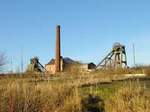

Section under development
The type of shaft signals originally installed at Pleasley is unknown. They may have been mechanical ones although with a shaft depth of 514 yds they would have needed some operating.

Mechanically operated shaft-signalling at the pit-bottom. Date & location unknown, probably mid-late 19th century (pitwork.net)

Mechanically operated shaft-signal indicator - late 19th century (JST)
It’s more likely that the shaft signals were electrically operated ones powered by the type of battery known as the Leclanché cell, invented in 1866. This type of cell had been rapidly taken up for use on telegraph and railway signaling systems and a company such as Stanton Ironworks with its modern outlook and its connection with the electrical engineering pioneer REB Crompton would almost certainly have opted for that type of system.

Certainly, by 1891, electric signals and telephones were in use on the electrically powered haulage system installed in the dip workings of the Top Hard seam [1] and by 1903/4 electric bells were in use with both winders although there appears to be only a single bell for each.


North winder signal bell, clock and ?pressure guage? circa 1904. (FoPP/JST)
South winder drivers chair and signal bell, circa 1904. (FoPP/JST)
When the Lilleshall winder was installed at the North-pit in 1904 it is not known what type of indicator system was fitted. A circuit diagram of a 1927 inter-deck signaling system at the North shaft shows the presence of Hopkinson visual signals. A Hopkinson Dial Indicator system is shown in the 1930s blueprints when Lilleshall installed a new braking system.


North winder blueprint detail showing location of Hopkinson signal gear, circa 1930. (FoPP/JST)
Hopkinson signal cancellation gear, circa 1928. (JST)
In 1922 when the Markham winder was installed at the South pit, an accumulative dial system manufactured by Davis & Sons, Derby was fitted there.
In 1927, the colliery electrical department designed and installed an inter-deck signal system for use with the simultaneous decking operations. This was installed at the pit-top and pit-bottom of both shafts and was enabled and reset by the arrival / departure of the cage. It prevented the transmission of a signal to the winder until the banksman / onsetter had received a clearance signal from the full and empty side operators of each deck.

Circuit diagram for the North pit bank inter-deck signal system, circa 1927. (JST)
In the late 1960s both signal indicator systems were replaced with the NCB specification system. They were almost certainly upgraded after the Markham disaster in the early 1970s to provide indication of incomplete and false signals. These remained in use until closure. Both display panels can be seen in the engine-houses.

South winder drivers chair and back of signal indicators, circa 1950. (FoPP/JST)

North winder NCB specification ATM signal display
Copyright © 2023 J.S. Thatcher
Page updated on:
11 Nov, 2023
at
05:24:42 PM
In case of problems contact: